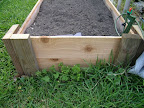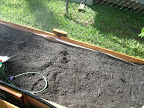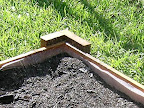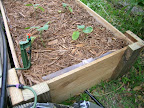Feel bad every time you look in the refrigerator vegetable crisper bins and find stuff going to rot? There’s a gardening bright side to this dilemma, and it’s called vermi-composting.
What’s that, you ask? It’s actually nothing more than a fancy term for composting using worms. It’s easy, and is probably one of the best things you can do for almost all your plants.
Worm castings, as they are called (conjuring up images of industrious little worms gracefully “casting” their… well… their “worm poo”), are one of the most nutrient-rich forms of organic fertilizer you can use. All you need is a dark-colored, covered-but-vented bin, some kitchen scraps, some moistened shredded up newspaper, and a pound or so of worms.
Not just any worms, mind you, but a couple of particular species that excel at producing this gardener’s black gold. The most common species used are the red wiggler (eisenia foetida) or the so-called European nightcrawler (eisenia hortensis), with the red wiggler being the most popular. The Euros are a bit bigger, and reportedly don’t produce quite as fine a final product, but, if they’re all you can get, should work just as well.
A dark-colored bin is best, since the worms don’t like light. Some ventilation is mandatory, and a method of drainage is also useful. You could use a plastic tote bin, found nearly everywhere, to start vermi-composting. Poke a few dozen holes in the lid with a very small nail– worms can squeeze through holes as small as 1/16 of an inch. Do the same around the perimeter of the bin about 2″ up from the bottom. Place a thick layer– 6 inches or more– of shredded moistened newspaper in the bottom. Not too wet or packed too tight– make it a bit fluffy, and none of the shiny slick stuff– and then add your worms. They will immediately burrow down into the newspaper to get away from the light. Add some vegetable scraps from the kitchen, cover them with a few layers of wetted newspaper (not shredded), and put on the lid. Check under the newspaper every few days to see the worms’ progress, adding more food scraps only as necessary. Add some more moistened torn-up newspaper from time to time, too– they’ll eat it as well.
Don’t have a paper shredder? Let your worms help prevent identity theft by feeding them your last month’s credit card statement– with today’s soy-based inks, your worms will devour it with no problem. Ultimately, your worms will eat half their weight in food every day!
A word about kitchen scraps: Vegetable or fruit peelings, coffee grounds, tea bags, stale cereal are all fine. No meats, fats, bones, or dairy products. Some say no onions or garlic as these have an antibiotic effect on the beneficial microbes in the compost. Others say go light on citrus rinds, as the the worms don’t like the acidity. Your worms will like you more if you chop up their food somewhat before adding it to the bin– it will make their work easier and faster. For tougher scraps, like broccoli stems, go ahead and cook them with the people part of the food, and then pluck out the worms’ share before serving. Also, be ready for a surprise if you put vegetable seeds in your bin– they’ll germinate and sprout like crazy in this dark, moist, fertile environment.
If you can, provide some kind of drain in the bottom of your bin, even if it’s only a hole with a cork in it. Moisture will work its way down and collect in the bottom. Draining it has several benefits. One, you won’t have any drowned worms– unlikely, but possible. Second, the liquid that you drain out isn’t trash, it’s the liquid form of this gardener’s black gold– worm tea. It will be very concentrated– you can add a mere few ounces of it to a gallon of water, and it will still be darker than strong coffee. Give all your plants a treat while you wait for the worms to finish their work. In a ten gallon tote bin, you can even safely add about a quart of water a week to help create more tea without seriously affecting the worms. Just don’t forget to drain it out and use it. If there’s more than you can use up, keep it in a jug with a hole punched in the cap, so the beneficial microbes therein can breath.
Keep your bin in a relatively cool location out of direct sunlight if kept outside. A garage or basement are also good spots. You can even keep it in your kitchen if you want– it has no unpleasant odor whatsoever (unless you perpetually over-feed). At most, your bin should have a subtle, natural, earthy aroma.
Once your compost is ready, it’s time to harvest it. How do you know it’s ready? Like regular compost, you won’t be able to discern any of the materials you put in the bin originally. Nothing will look like paper or kitchen scraps or tea bags at all.
How do you harvest it if it’s still full of worms? Simple. One way is to only feed them on one
side of the bin. The worms will move to that side to feed, leaving the other side virtually worm-free. Another way is to spread out sheets of newspaper on a table. Gently scoop out baseball-sized mounds of compost and place them in rows on the newspaper. Turn on a bright light directly overhead. The worms will move downward in the mounds, and you will be able to brush or scoop off the tops of the mounds a little at a time as they do.
The bin described above will produce plenty of worm compost and worm tea for the average gardener or plant keeper, but, if you prefer a more elegant solution, there are products like the Can-O-Worms.

It has a vented base, a vented cover, and three trays which are used in rotation. You start with a single covered tray sitting in the bottom section, and feed the worms until the compost fills the tray up to a certain level. Then you add another tray, and put some newspaper-covered food in it. The worms move up to the upper tray as they finish composting their food and bedding in the lower tray through hundreds of worm-size holes. The bottom section even has an island for worms who fall through the bottom tray to get out of the collecting liquid and back up into the trays. A handy drain with a valve is provided to dispense worm tea. A starter block of bedding is included– about the size of a large brick, it expands to almost 4 gallons in volume when water is added. The worms, if not available locally, can be mail ordered from worm farms all over the country. Keep them happy, and they will make vermi-compost– and lots more worms– for years to come.




